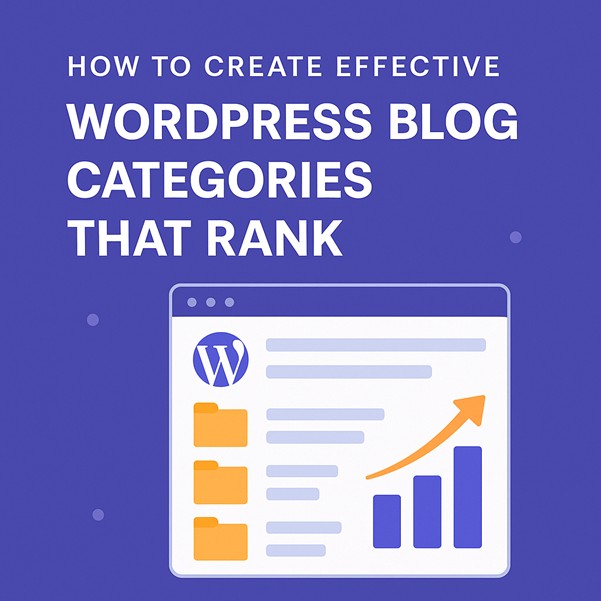If you want your WordPress blog to attract more readers, rank higher in search engines, and offer a better user experience, one simple but often overlooked strategy is improving your blog categories. Many blogs treat categories as an afterthought, leading to messy site structures, poor SEO performance, and frustrated readers. In this guide, you’ll learn how to create effective WordPress blog categories that not only organise your content beautifully but also help your site climb the search rankings in 2025 and beyond.
Why WordPress Blog Categories Matter
Categories are the main way you structure your blog content. They:
- Help users navigate your site and find related content
- Influence your site architecture, which affects SEO
- Allow search engines to understand the themes and topics your site covers
In short, a strong category structure makes your blog easier to use and easier to rank.
Common Mistakes with WordPress Categories
Before we dive into how to create great categories, it’s important to recognise common mistakes:
- Too Many Categories: Having dozens of categories with just one or two posts each can confuse readers and dilute SEO authority.
- Overlapping Categories: If multiple categories cover the same topics, it weakens your site’s structure and confuses search engines.
- No Descriptions: Empty category pages without introductory text miss opportunities for SEO and user engagement.
- Default “Uncategorized”: Leaving posts in “Uncategorized” looks unprofessional and hurts site organisation.
Step-by-Step: How to Create WordPress Blog Categories That Rank
1. Plan Your Content Topics
Before setting up categories, think about the major themes you’ll cover on your blog.
For example, if you run a digital marketing blog, your main topics might be:
- SEO
- Content Marketing
- Social Media
- Email Marketing
- Paid Advertising
Each of these can become a category.
Tip: Think broad enough that you can write multiple posts under each category but narrow enough that it’s meaningful.
2. Limit the Number of Categories
There’s no magic number, but a good rule of thumb is to aim for 5–9 main categories. This keeps your blog structure simple and easy to navigate.
You can always add subcategories later if you need more detailed organisation.
Example:
- Category: SEO
- Subcategory: On-Page SEO
- Subcategory: Link Building
3. Use SEO-Friendly Category Names
Choose clear, descriptive names that people actually search for. Avoid clever or vague terms.
Instead of:
- “Insights”
Use:
- “SEO Tips” or “Content Marketing Strategies”
Good category names tell both users and search engines exactly what they’ll find inside.
4. Write Category Descriptions
In WordPress, you can add a description for each category. This is a fantastic SEO opportunity.
Your description should:
- Briefly introduce the topic
- Include relevant keywords naturally
- Encourage users to explore
Example for an SEO category:
“Discover expert advice and actionable tips on search engine optimisation (SEO). Learn how to improve your website rankings, drive organic traffic, and grow your online presence.”
5. Optimise Category Page Content
Instead of leaving category pages as simple post listings, enhance them with rich content:
- Add a custom heading
- Write a short intro paragraph
- List featured posts
- Include internal links to related categories or posts
Some premium WordPress themes and plugins let you customise category pages more easily.
Well-optimised category pages can sometimes even outrank individual posts!
6. Create a Logical URL Structure
WordPress automatically creates URLs like: yourdomain.com/category/seo/
This is fine, but if you want an even cleaner structure, you can remove “/category/” by tweaking your permalinks or using a plugin.
Simple, keyword-rich URLs help with SEO and make links easier to share.
7. Ensure Consistent Internal Linking
Every time you write a blog post, link relevant keywords back to your category pages.
Example:
“To learn more about building high-quality backlinks, check out our full link building category.”
Internal links:
- Help users discover more content
- Distribute link authority across your site
- Reinforce topic relevance for SEO
8. Regularly Audit and Update Categories
As your blog grows, you may need to:
- Merge similar categories
- Split large categories into smaller subcategories
- Delete empty or unused categories
Set a reminder to review your blog categories every 6–12 months.
Advanced Tips for WordPress Blog Category SEO
- Add Featured Images: If your theme supports it, add a featured image for each category to enhance visual appeal.
- Schema Markup: Use plugins like Rank Math or Yoast SEO to add schema to category pages for better search presentation.
- Custom Meta Titles and Descriptions: Optimise your category pages’ SEO titles and meta descriptions manually.
- Include FAQs: Adding a few frequently asked questions to category pages can improve SEO and user engagement.
Real-World Example: Organising a Digital Marketing Blog
Imagine you run a blog for a digital marketing agency. Here’s a simple, SEO-friendly category structure:
- SEO
- On-Page SEO
- Technical SEO
- Content Marketing
- Blogging Tips
- Content Strategy
- Social Media Marketing
- Instagram Marketing
- LinkedIn Strategy
- Email Marketing
- Paid Advertising
Each main category could have an introductory paragraph, links to top posts, and optional subcategories where needed.
How Algo Digital Can Help
At Algo Digital, we know that effective site architecture is the backbone of successful SEO. A messy blog structure doesn’t just confuse your visitors — it confuses Google too. Our team specialises in:
- WordPress SEO audits
- Category page optimisation
- Content strategy and planning
- Custom WordPress development
Whether you’re launching a new blog or restructuring an old one, we can help you set up a category structure that drives traffic, improves engagement, and grows your brand authority.
Ready to build a WordPress blog that ranks higher and works smarter? Contact Algo Digital today and let’s make it happen.



